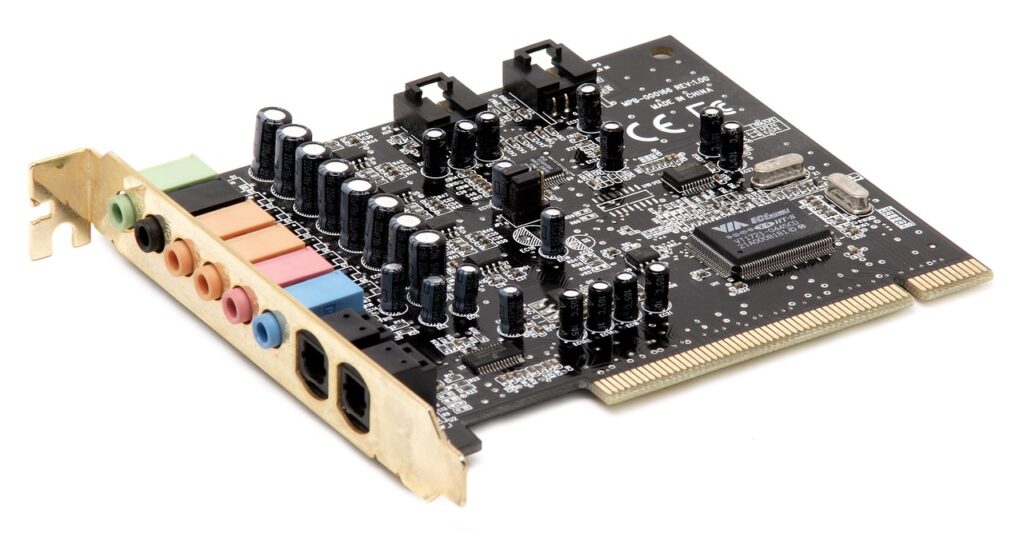A sound card is also known as a audio card. It is a internal expansion card that provides input and output audio signals. Generally, A sound card is control by a computer programs. The term sound card is apply by external audio card interface which is uses by professional audio applications. In newer generation computers, a sound card is built-in to the motherboard. The integrated sound card is still refer as a sound card.
The sound processing hardware is also present in modern graphics cards with HDMI cable. previously they uses a S/PDIF connection to motherboard. Typical uses of sound cards is to provide functionality in music composition, editing video or audio, presentation, education, games etc. Sound card are also uses for computer based IP and teleconferencing.
History of Sound Card
A compatible sound cards for IBM PC were uncommon until 1988. For most of the IBM PC users, internal speakers is only way to produce sound and play music. The hardware of speaker is typically limited to square waves. The result sound is like “BEEPS and BOOPS”. The several company access software which develops techniques for digital sound productions. When sounds plays, all the process is stop. Early sound cards for the IBM PC platform were not design for gaming or multimedia.
In 1988, A computer game CEOs stated at the consumer electronics show that the PC’s limited sound card capacity prevent it from leading home PC, It need around 50 to 80 dollars soundcard with better capability. Sierra On-Line, A pioneered supporting EGA and VGA video promised that year to support the Adlib.

Characteristics of Sound Card
Sound card uses a converter calls digital-to-analog converter(DAC). It converts recorded digital signal dat into an analog format. When output signal is connected to an amplifier, headphones or any other outside external device. A very common external connector is the microphone connector. Generally in most sound cards have a line in connector for input from a sound source that has higher voltage levels. In other cases, the sound card uses an analog-to-digital converter to digitize this signal.
Sound Channels and Polyphony
The most important characteristic of sound card is polyphony, which refers to its ability to process and output voices or sounds. This channel is see as the number of audio outputs. This output correspond to 2.0(stereo), 2.1(stereo and sub woofer), 5.1(surround) etc. Sometimes the term voice and channel are uses to indicate the degree of polyphony. I.e. In much older sound chips accommodate three voices, but only one output channel.
In early PC sound cards have a multiple FM synthesis voices which were used for MIDI music. The full capabilities of advanced cards are often not fully used. A modern integrated sound cards which comes with low price or standards or even lower-cost expansion sound cards still work this way. This sound cards actually have no hardware polyphony but provides more than two sound output channels. This fully task is performs entirely in software.
Hardware Manufacturers
The first manufacturers of sound cards for the IBM PC was Adlib. It produces a card based on the Yamaha YM model sound chip. A creative Labs also marketed a sound card about the same time calls creative music system. The basic technology behind it was based on Philips SAA1099 chip. after that creative rename it to the game blaster.
This game blaster retail under 100 dollars and it was compatible with many popular games. A large change in the IBM PC compatible sound card market which introduced the sound blaster card. The sound blaster cloned the Adlib and added a sound coprocessor for recording and playback of digital audio. This card also includes a port for gaming joysticks. Most buyers chose sound blaster.
Industry Adoption
A game industry supports add on music hardware in addition to built in hardware like PC speaker and Built-in sound capabilities of IBM. The two of the companies calls sierra partnered with were Roland and Adlib. Since it was the most sophisticated synthesizer they support this functionality. Many video game companies also supports MT-32.
Feature Evolution
Early ISA bus sound cards were half-duplex which means they couldn’t record and play. Later ,ISA cards like the SoundBlaster AWE series. It is like Plug and play SoundBlaster clones supported simultaneously rec or playback. Generally PCI bus are mostly full-duplex and do not have these limitations.





Simply desire to say your article is as surprising The clearness in your post is simply excellent and i could assume you are an expert on this subject Fine with your permission let me to grab your feed to keep up to date with forthcoming post Thanks a million and please carry on the gratifying work